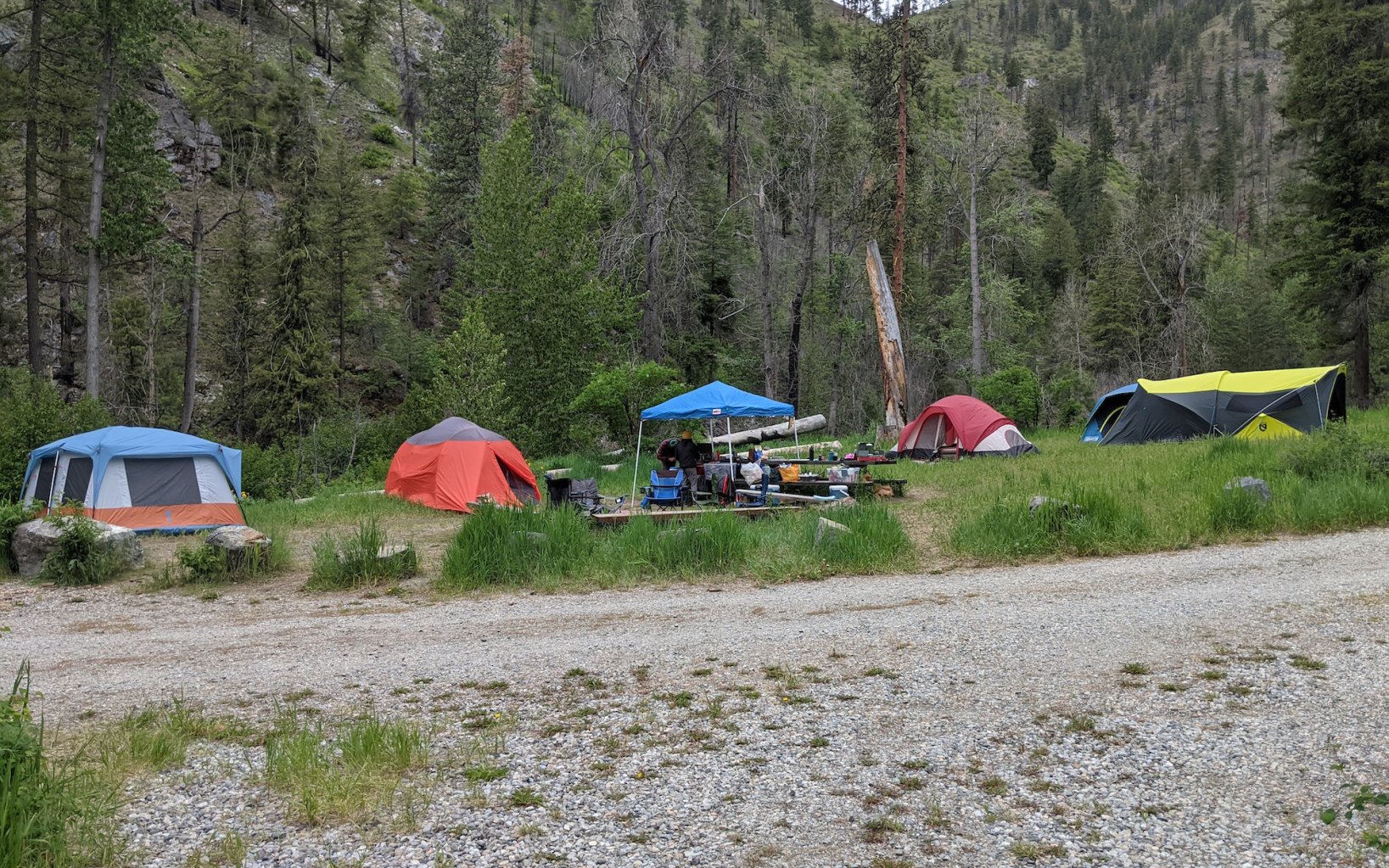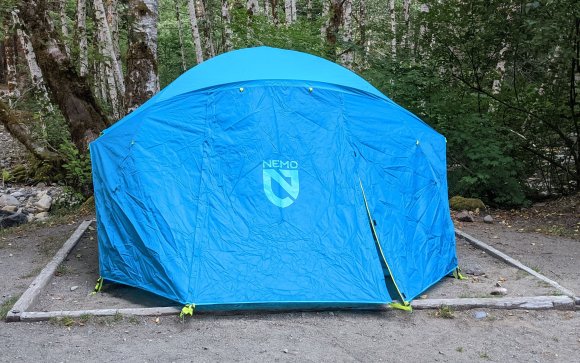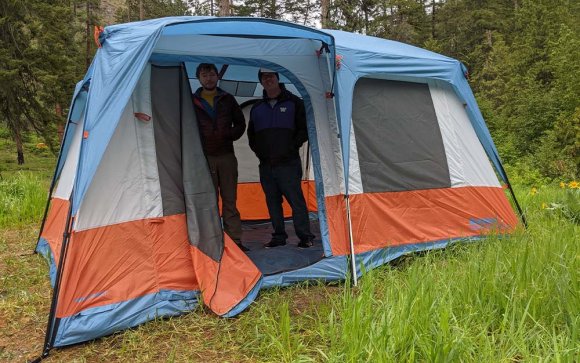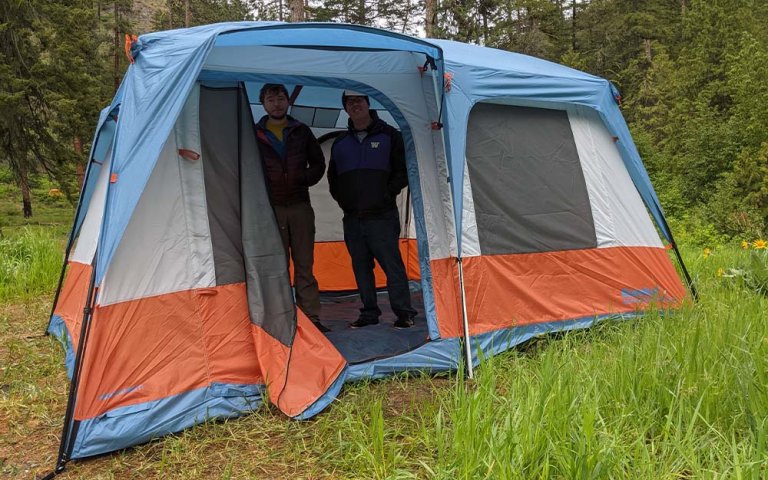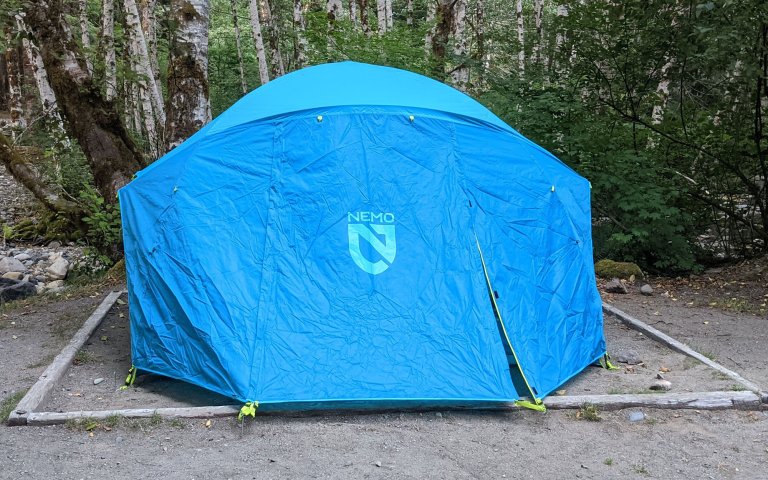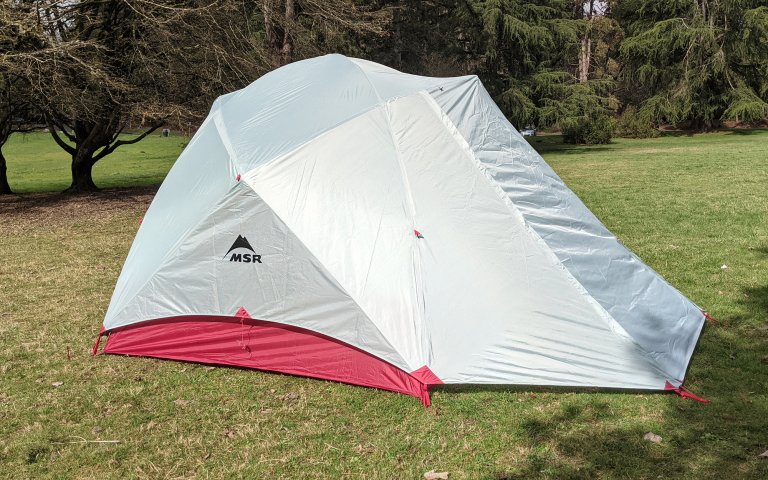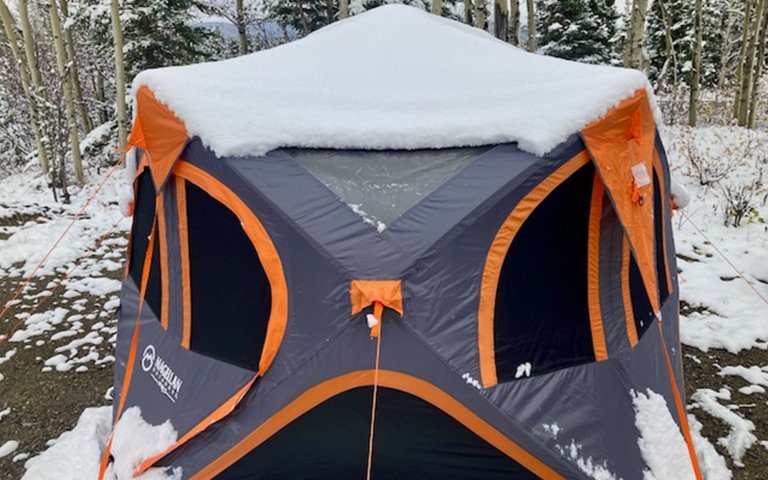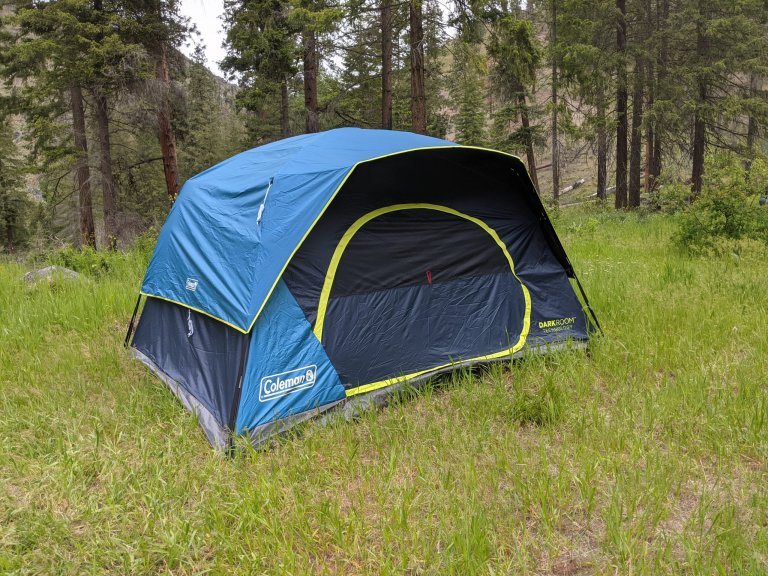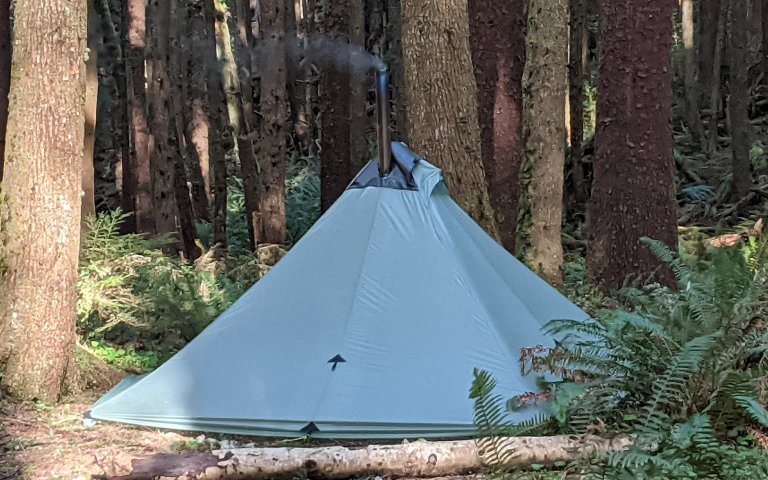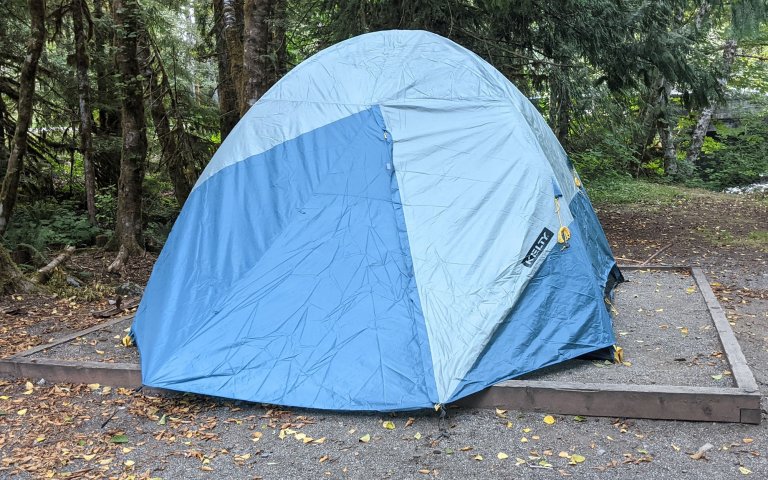We may earn revenue from the products available on this page and participate in affiliate programs. Learn More ›
There is no more important piece of gear on camping trips than the family tent. But with so many tent designs, materials, and features available, it can be tough to know which is the best—especially if you have a larger family that needs space to spread out. I tested top picks from NEMO, Big Agnes, Coleman, MSR, Eureka, Kelty, and more in everything from thunderstorms to heavy winds to help you find the best family tent for your next camping adventure.
Best Overall: Eureka Copper Canyon LX8
↓ Jump to Review
Best for Four-Person Families: NEMO Aurora Highrise 6P
↓ Jump to Review
Best for Three People: MSR Habiscape 4P
↓ Jump to Review
Best Instant: Magellan Outdoors Pro SwiftRise 4-Person Hub Tent
↓ Jump to Review
Best Canvas: Springbar Traveler
↓ Jump to Review
Best Blackout: Coleman 4-Person Dark Room Skydome
↓ Jump to Review
Best for Backpacking: Seek Outside Cimarron
↓ Jump to Review
Best Value: Kelty Discovery Element 6
↓ Jump to Review
How I Tested the Best Family Tents
I conducted field tests of tents across a range of size and activities with the help of Outdoor Life staff, friends, and my family. The best 8-person tents were tested over three days in a river valley where heavy winds broke the poles of one tent (and sprung a leak in another). The best 6-person tents were tested in the heavy rain of a late summer thunderstorm. Our pick for backpackers looking for a family camping tent was part of our test of the best ultralight tents. Other tents included on this list have been taken out with my own family on various camping trips in heat, wind, and rain across our usual stomping grounds of the Pacific Northwest.
Best Family Tents: Reviews & Recommendations
Best Overall: Eureka Copper Canyon LX8
Pros
- Great livable space on the interior
- Withstood both rain and wind on the testing trip
- Lots of doors and windows
- Great value
Cons
- Most complicated setup in my test (fortunately the provided instructions were easy to follow)
- Heavy
Key Features
- Dimensions: 13 feet x 10 feet
- Height: 7 feet
- Weight: 33.5 pounds
- Poles: 10
- Packed Size: 11 inches x 29 inches
- Doors: 2
- Windows: 6
- Also available as a 6-person tent and 4-person tent
I was a little skeptical when I first started linking together the poles of the Eureka Copper Canyon LX8. Six windows and two doors, with a rain fly that looked suspiciously like a camping canopy? With winds gusting during and after setup, I kept a close eye on this one
While the strongest winds during testing buffeted the sides of this tent, it bounced back quickly without damaging the fiberglass poles. At one point the rainfly came unattached at a corner, but after a member of the testing group re-secured it with the provided velcro tabs (which I forgot to do during the initial setup), it wasn’t a problem. And the rainfly turned out to be plenty of protection against overnight rain once the windows were zippered up.

Even better, the ceiling height (seven feet) combined with the near-vertical walls on this one made it easy for the 6-foot 1-inch member of the family to walk around without having to stoop at the edges.

Setup is straightforward, if a little complicated. Three fiberglass poles crisscross the ceiling and then connect to six steel poles at each end to form the walls (the tenth pole creates the awning over the doorway). The directions for this were reasonably easy to follow—it just took a while. The only downside to this tent is that the 8-person tent requires a second person to complete the setup. While I was able to put up the body of the tent by myself, putting up the rainfly requried a second (taller) person.
Best for Four-Person Families: NEMO Aurora Highrise 6P
Best Overall
NEMO Aurora Highrise 6P
See ItPros
- Easy one-person set up
- Plenty of vestibule space
- Great headroom across the interior of the tent
- Spacious floor design allows for different configurations
Cons
- Window closure mechanism is not as secure as it could be
- The blue interior color is very intense
Key Features
- Dimensions: 100 x 120 inches (83.3 square feet)
- Height: 77 inches
- Weight: 18 pounds, 10 ounces
- Poles: Four
- Packed Size: 26 x 9.5 x 9.5 inches
- Doors: Two
- Windows: Two
I barely remember setting up the NEMO Aurora Highrise 6P Tent, which is about the highest praise I can offer. Insert the two longest poles through the crisscrossing sleeves, anchor them into the grommets at opposite ends, and secure a handful of tabs to pull the body taut.

Something nice about the NEMO Aurora Highrise 6P Tent was that the two lengthwise poles attached to the rainfly, and were pretty taut (although not unnecessarily difficult to get into place), which helped to keep the rainfly off of the body of the tent. That ended up being extra important as the ground at my testing site turned out to be fairly difficult to stake into.
On the tent pads, the ground was firm but pliable—ideal for staking in—but everywhere else it was very compacted, and virtually impossible to get more than an inch in. This is a common scenario for car camping these days, so I was curious to see how the tents would handle the less than ideal staking situation. But I was less worried about my poor staking job with the NEMO Aurora Highrise 6P Tent because of the taut structure provided by the poles and fly alone.

The bright glowing blue of the interior is perhaps the most memorable (and divisive) part of this tent. It’s very blue. It sort of offers the impression of a bright sunny day, even as the clouds rolled in—PNWers may be reminded of an infamous Pemco commercial. Unfortunately, that means it also washes out all other colors. Personally, I might have chosen a different color if NEMO offered one (they don’t, currently).

There was an unusually serious thunderstorm the night I tented this test. Rain was dumping. The sky was booming. The Aurora Highrise held taut against the rain. I spent some time considering the relative distance between our location and the actual lightning strikes (no family tent is going to protect you from a direct hit), but once I was comfortable it wasn’t headed our way, it was easy to fall back asleep again. I just felt safe in this tent.

Beyond the blue coloring, my only other concern with this tent was the windows at the side. They close up from the inside with a simple toggle mechanism. While this wasn’t an issue with a straight up and down rainfall (the rainfly covers it by a few inches), in a storm involving both rain and wind, this could prove to be a failpoint.
Best Family Tent for Three People: MSR Habiscape
Pros
- High ceiling height extends around the tent
- Great stuff sack
- Designed to handle inclement weather
Cons
- Smaller vestibule than other 4-person tents
Key Features
- Dimensions: 95 x 95 inches (62.5 square feet)
- Height: 73 inches
- Weight: 12 pounds, 11 ounces
- Poles: Six
- Packed Size: 24 x 9 inches
- Doors: Two
- Windows: None
The MSR Habiscape is one of those family camping tents that doesn’t look like much when you first set it up, but the longer you spend with it, the more it starts to grow on you. It starts with the headspace—plenty enough for this five-foot-five gear writer to stand up in, not just at the center, but also along the sides and at the doors. Then there are the pockets—10 in total—including two that can be accessed from outside the tent (no more taking off and putting on your rain jacket and shoes just to store the car keys).

Finally, the stuff sack was great. That might seem like an unimportant detail when you are first setting up your tent, but when it’s time to pack away at the end of the weekend—the rainfly soaked from an overnight shower, dirt stuck to the bottom of the body—the excellence of the stuff sack becomes clear.

While most tent stuff sacks open at the end, the MSR Habitude stuff sack opens along the side. After a drizzly morning of testing, instead of carefully rolling up the tent into a cylindrical burrito, I simply stuffed the rainfly and body in as best I could, shoved the stake and pole bags on top, cinched the cord and tightened the compression straps. It wasn’t pretty, but it was now ready for transport with a minimum of hassle.
Best Instant: Magellan Outdoors Pro SwiftRise 4-Person Hub Tent
Pros
- Easy setup
- Spacious for four adults
- Durable
- Interior storage space
- Adjustable windows
Cons
- Expensive
- Rainfly can blow off
- Heavy
- Not compact for long-term storage
Key Features
- Peak Height: 6.5 feet
- Weight: 24 pounds
- Adjustable ventilation
- Eight side pockets and one gear loft
- 20+ UV protection
- Integrated lighting system
This one-room, square tent stood out from all the rest of the tents, and will now be my go-to car camping tent. With a center height of 6.5 feet, it can accommodate even the tallest campers. Plus, the 60 square feet of floor space was more than enough to sleep four people.
Out of the box, it was a cinch to set up by deploying the ceiling into place, then pulling the four side hubs outward. It comes with too many stakes (small and large ones) to secure the edges and guy lines.
One highlight was all the windows with mesh screens and shades that can be strapped over or rolled up. Not only was the natural light welcomed, but the amount of ventilation resisted any moisture buildup. An integrated, battery-operated light system surrounds the interior roof for ample nighttime light. It has a head-level gear loft and eight pockets, offering plenty of storage options.


What really made this tent stand out is that it is extremely durable. I had this up for over two months in all types of weather, including 40-mph gusty winds, driving cold rain, and even wet snow. A few inches of wet snow collapsed the tent, but once I removed it, the tent sprung right back into position. The 150-denier polyester offered proven durability and protection for the contents inside.
There is an additional rain fly that attaches to the bottom of the tent, however, in the strongest winds, it can become detached. — Justin La Vigne
Best Canvas: Springbar Traveler
Pros
- Watertight
- Breathable
- Insanely durable
- No-see-um window mesh
- Made in the USA
- Waterproof floor
- One-person setup
Cons
- Heavy
- Takes a little elbow grease to put up
- Must be put away dry
Key Features
- Materials: 100 percent cotton canvas
- Footprint: 10 x 10 feet
- Interior Height: 6.5 feet
- Packed Tent Size: 21 x 15 inches
- Packed Pole Size: 56 x 8 inches
- Tent Body: 42 pounds
- Pole Set: 22 pounds
- Stakes: 8 pounds
- Non-freestanding
- Price: $1,299
Just as we finished erecting the tent, all seven of us piled in. The rain started to pour and the packed desert dirt immediately began to flood, waterfalls cascading down nearby sandstone. Parts of the floor started to trap small puddles underneath like tiny waterbeds. And the wind picked up menacingly; my friend turned to me and asked, “Are you sure this’ll hold?”
“I’d trust this tent with my life,” I said.
The last car camping tent you’ll ever buy: the Springbar Traveler. In our short four months together, this tent has withstood, rather, thrived in high desert winds, monsoons, hail, and scorching heat. The 10 by 10 footprint isn’t overly large, and the tight design takes advantage of every foot. It’s 6.5 feet tall wherever you stand. It’s extravagant for two, comfortable for four, and fits six. Though more can easily wait out a storm, as this tent is bombproof. Springbar tents are designed for high winds. It starts with 12-inch galvanized steel wedge stakes made in Missouri. They’re secured to the tent with steel wire stake loops fixed to a rope lining the perimeter. The rope not only reinforces the attachment points, but also distributes the weight. The frame operates with tension and flex using a spring system. The aluminum poles’ interior is reinforced with steel. They fix into spring steel tension rods to solidify the tent frame. Made in Salt Lake City, Utah, these poles are corrosion resistant and the aluminum lightens the overall weight.

While the seamless vinyl floor is completely waterproof, Springbar tents aren’t. They’re watertight. And while that sounds like a recipe for disaster, it’s where the real magic of this tent begins. Instead of the suffocating bright colored nylon you’re used to, the 100 percent cotton canvas breathes. The Sunforger (gold-standard weather finish) treated cotton shrinks when wet and the tiny holes and seams tighten, keeping water out.
Even the three different threads used in Springbar tents are specially selected and sewn to constrict and swell with the fabric. When dry, the cotton naturally expands to create a more breathable shelter in hot weather. The three full-length no-see-um mesh windows and door don’t hurt either. In cold weather, it’s harder for heat to escape. Springbar tents are warmer in winter and cooler in the summer. It’s by far the most comfortable tent I’ve ever slept in.


Now, you might be thinking that it takes blood, sweat, and tears to erect this bombproof tent, but you’d be wrong. I’m a 5-foot-7 female and I’ve done it by myself. The most time consuming part is hammering in the stakes, but it goes a lot faster with even one more person. Once you lodge all 20 stakes into the ground with a hammer or mallet, you’re basically done. Sure there are a couple more steps, but the hard part is over. Springbar has an excellent video showing how to put it up solo. Pro tip: Pre-align your upright poles so that you can lift directly up, instead of spinning the pole around to find the holes and lifting at the same time.

The legendary weather-resistance and Goldilocks size aren’t the only things that make the Springbar tent special. You’re stuck with it for the rest of your life. When I toured their facility here in Salt Lake City, Utah, their repairs specialist was working on a tent from the 1970s. All it needed? some new mesh. With proper care, these tents can last decades and in some cases, generations. If you do need a repair, Springbar does it all in-house at their Salt Lake City sew shop.
This tent’s only kryptonite is mold. Under no circumstances should you store this tent wet. If you’re forced to pack up camp while it’s wet, let it dry when you get home. Mold will cause irreparable damage. But, the weather treatment is mold-resistant and Springbar hasn’t found any issues storing the tent in humid areas like the Northwest or Southeast as long as you store the tent in a dry place.

The packed size of the body of this tent is 21 by 15 inches. You also have to bring the 56 by 8-inch bag of poles, but hey, at least they’re skinny. Compare that to the winner of the Best 6 Person Tents test: the Nemo Aurora Highrise 6P Tent at 26 by 9.5 and it isn’t so bad. It’s a little bulky, but to me the space is absolutely justified for the comfort I get once it’s set up at camp. As I said, hammering the stakes takes the most effort, but they are crucial to the structural integrity of the tent.

The stakes are so important because the tent is not free standing. The upright poles are tensioned and pull up on the stakes. On one desert trip, I wasn’t able to stake down the tent because the ground was too hard, so I had to improvise. While I’m sure Springbar wouldn’t recommend it, and you’re endangering the seamless vinyl floor, I successfully weighted the tent down using large rocks inside. And it was awesome. When I removed the rocks for takedown, I checked the floor and didn’t notice any tears or punctures (or any wear at all).


The inside of the tent is spacious and tall. I’ve spent the night in this tent comfortably with two, three, and four people. During a mid-day hail storm, six of us napped inside without issue. And I’ve spent two rainy evenings with seven people inside watching a movie we projected on the conveniently white canvas. The fact that an entire group can comfortably relax inside this tent is one of its major advantages. Whether it’s raining, buggy, or cold, there’s a cozy shelter ready to bring the group together.
After my first few trips with the Springbar, it was looking a little dirty; it is white after all. I was disappointed until a rain storm came along and left it looking good as new. With some easy maintenance and simple care instructions, I believe this tent could last me the rest of my camping days. The lifetime of a canvas tent, and its ability to be repaired, makes it more sustainable than a synthetic tent. Plus, cotton is an organic material that biodegrades, unlike nylon. The Springbar’s killer design and aesthetics makes it way more fun, too.
Springbar has a number of different canvas tent options. The size ranges are 6×8, 7×9, 8×10, 10×10, and 10×14. The models can be cut and sewn by hand in Salt Lake City, like the Traveler, or imported. The imported tents cost less, competing with other imported canvas tents, but still use the traditional Springbar design and undergo diligent testing.
If you’d like to save on a USA-made tent, you can also check out Springbar’s factory seconds page. They offer tents with only aesthetic issues for a discounted price. All of the tents are available in the following colors: pear gray, bison, natural, and suntan. Two of Springbar’s tents, the Classic Jack 140 and Skyliner, are even compatible with stoves.

It’s a delight to get back to camp and see this home-away-from-home standing there. And it’s comfortable to hang out in, should the weather turn or you need to escape from bugs in the evening. But most of all, it gives you peace of mind. Whether you’re tucked in your sleeping bag or away from camp, there’s no doubt this tent will stay standing. My guide at the sew shop in Utah said that he had a Springbar tent up in his backyard for three years without issue. I think if you spend e
Best Blackout Family Tent: Coleman Dark Room Skydome
Pros
- Dark interior is perfect for midday naps or camping during the summer solstice
- Reasonably easy setup
- Affordably priced
Cons
- Smaller than other tents in my test (would only fit two Queen-size camping mattresses)
Key Features
- Dimensions: 12 x 9 feet
- Height: 76 inches
- Weight: 20.5 pounds
- Poles: 3
- Packed Size: 27 x 10 x 9 inches
- Doors: 1
- Windows:
If you’ve ever planned to sleep in while camping, then woken up as soon as the sun hits your tent at five in the morning, then the appeal of the Coleman Dark Room Skydome is pretty clear. In the middle of the day, with the sun brightly shining down on you, you can go inside this family tent and it’s pretty close to pitch black. Just a small amount of light sneaks in at the corners and around the edge of the door. It’s also much cooler than comparably enclosed tents.

This tent (I tested the 8-person version, but it’s available as a 4-person or a 10-person) was also fairly easy to set up. The two main poles, which are attached to the far corners of the tent, simply crisscross over each side—a super simple design that will be familiar to anyone who has ever used a 2-person tent. Unfortunately, this design also comes with some limitations. At 108 square feet, this was the smallest so-called 8-person tent in my test. I would not recommend trying to squeeze more than four people in this tent, maybe five if you are exceptionally good friends. It also buffeted in the wind fairly significantly, although the fiberglass poles survived the encounter.

The final pole—a separate fiberglass section that holds the rainfly out over the door was surprisingly difficult to insert.
Best for Backpacking: Seek Outside Cimarron
Pros
- Straight-forward set up
- Very lightweight for its footprint
- Came with some the best tent stakes of any ultralight tent I looked at
- Option to pair with a lightweight titanium stove
Cons
- Huge footprint can make it hard to find a suitable pitch site
- No floor (option to purchase a floor if you do not plan to use the stove)
Key Features
- Dimensions: 114 x 102 inches
- Height: 72 inches
- Weight: 2 pounds, 7 ounces (not including the optional stove)
- Poles: One (not freestanding)
- Doors: 1
- Windows:
First off, the Seek Outside Cimarron is an exceptionally easy tent to set up. The first step is to stake out the four corners of the tent, a task made easier by the long (almost 10 inches) twisted aluminum stakes—I was comfortable pounding these in with a rock and they held significantly better than any other stakes provided for this test of the best ultralight tents. Then simply assemble the pole sections together at the lowest length setting, position it in the center of the tent, and adjust it up until it’s at its highest setting. (If you choose to pair this tent with the stove, it’s a bit more complicated, but still straight-forward enough to assemble.)
Without the stove, this tent is surprisingly spacious on the interior, and would easily fit four adults plus gear (assuming they were careful). If you’re an experienced adventurer looking to take a couple of littles to the backcountry, this is a great option that will leave plenty of space in your pack for all the other essentials.

The only pitfall for this tent is that it can be a challenge to find a place for it. With the huge footprint and need to stake the tent down, you might spend more time searching for a spot to set up than actually setting up.
Best Value: Kelty Discovery Element 6
Best Budget
Kelty Discovery Element 6
See ItPros
- Affordable
- Easy to set up
- Waterproof
Cons
- More claustrophobic interior space than others in my test
- Somewhat less headroom
- Rainfly is not taut unless staked out
Key Features
- Dimensions: 107 x 120 inches (89 square feet)
- Height: 77 inches
- Weight: 15 pounds, 13 ounces
- Poles: 2
- Doors: 1
- Windows:
Spending $500 on a tent is hard. If you’re outfitting your whole family for the first time, it’s cost prohibitive. That’s why I was so pleased with how well the Kelty Discovery Element 6 handled my testing protocol. With just two crisscrossing poles, it was a cinch to put up. Given that the poles connect into sleeves at opposing corners (rather than fiddly grommets), it was arguably one of the easiest family tents to set up that I’ve tested. If you’re a first-time camper worried about the hassle of tent setup, this one is a great choice.

The heavier duty material being used for the Kelty Discovery Element 6 meant that the interior was unusually dark. If you’re camping with young children who still need daytime naps, that can be a boon, but it does mean that you’ll need to have a headlamp or camping flashlight on hand to see anything as soon as dusk settles in. At the end of the aforementioned overnight thunderstorm, this tent was completely dry on the interior.

While this is marketed as a 6-person tent, it would be a tight fit for four adults. If you have two small children, your family will likely fit fine, but if you’re kids are approaching full size then consider opting for a larger tents.
How to Choose the Best Family Tent
Square Footage
As anyone who has bought a tent for family knows, the stated number of people a tent can fit and the actual number of people you would want to fit in a tent can vary significantly. And gear like sleeping pads and sleeping bags will quickly take up room. Check the dimensions of any tent you are considering to determine whether it will fit the family or group you will be camping with.
Ease of Set Up
While I was able to set up all but one of the six-person tents for family camping I looked at by myself, I was only able to set up one of the 8-person tents by myself. If you are camping with young children that need constant supervision, prioritize tents with single-person setup. One rule of thumb that can help you determine how long it will take to set up a tent is to look at the number of poles. Typically, more poles will indicate a longer, more complicated set-up time, while a tent with fewer poles should come together relatively quickly.
Ceiling Height
One of the great joys of the best tents for family camping is finally being able to stand up inside. However, easier tents to setup typically have shorter ceiling heights while tents that have upwards of six feet on the interior can be difficult for shorter people to set up independently. Aim for a tent that has just enough head height for the tallest member of your family.
Packed Size
A large footprint unfortunately also means more space taken up in transit. If you have a smaller car, consider choosing a family tent with a smaller packed size.
FAQs
The best tent brands are those that have decades of experience in the outdoors, be it camping or backpacking, and are attuned to how the engineering details of a tent make it more or less adaptable to different climates or weather conditions. Most, although not all, also use higher quality material that will typically last longer than lower grade nylon or polyester. Finally, a high-quality tent will have a long warranty period—if a manufacturer isn’t willing to guarantee their tent for a family for more than a season, it probably isn’t any good.
The biggest factor in camping comfort is warmth. If you’re cold, you’re going to be uncomfortable. Purchasing a high quality sleeping pad will not only cushion you against the ground, but it will also insulate you from the cold of the ground. When choosing a sleeping bag, look for something rated at least twenty degrees lower than what you expect your coldest overnight temp to be. Bring blankets. Lots of blankets.
There are pros and cons to every tent design. A traditional, straight-walled cabin-style shelter can offer a lot of interior room and headspace, but the flat walls act like sails in strong winds. A dome-style tent isn’t as susceptible to wind, but doesn’t offer as much headspace or room to roam. Whichever style you choose, make sure the poles and materials are built to handle conditions you might encounter, and don’t be afraid to invest in additional, extra-long, heavy-duty ground stakes to keep it secure
Getting settled inside a tent doesn’t just mean unrolling a sleeping bag where you plan to catch some Zzzs. It also means keeping essential items like flashlights, water, eyeglasses, and other things within easy reach. Consider where people will sleep and stash gear in relation to the storage spaces and pockets incorporated into the tent, as well as other creature comforts like where you might hand an LED lantern to illuminate the inside at night.
While nearly every tent comes with a rainfly, most only cover the very top portion of the shelter and don’t do much to keep wind and moisture from penetrating through windows or porch screens. If you want 100 percent coverage, get a tent with a rainfly that reaches completely to the ground, all the way around the tent.
You cannot insulate a standard family tent for winter. Consider purchasing one of the best 4-season tents (which will provide additional insulation and structural support against snow loads) or looking into warmer layers and a sleeping bag.
Family tents can cost anywhere from $200 to upwards of $1,000 or even more depending on their size and level of quality.
Final Thoughts on the Best Family Tents
Camping trips in the family tent are memories that will last a lifetime, for you and your kids. The picks on this list are from reputable brands—Kelty, NEMO, Big Agnes, Coleman, Eureka—that are sure to last your family for many years to come.
- Best Overall: Eureka Copper Canyon LX8
- Best for Four-Person Families: NEMO Aurora Highrise 6P
- Best for Three People: MSR Habiscape 4P
- Best Instant: Magellan Outdoors Pro SwiftRise 4-Person Hub Tent
- Best Canvas: Springbar Traveler
- Best Blackout: Coleman 4-Person Dark Room Skydome
- Best for Backpacking: Seek Outside Cimarron
- Best Value: Kelty Discovery Element 6
